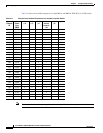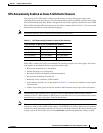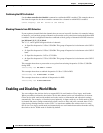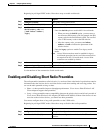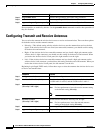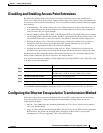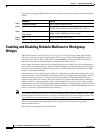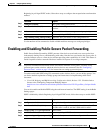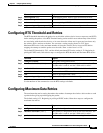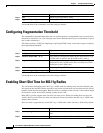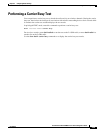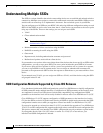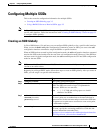
2-26
Cisco Wireless ISR and HWIC Access Point Configuration Guide
OL-6415-04
Chapter 2 Configuring Radio Settings
Configuring Beacon Period and DTIM
Use the no form of the command to disable PSPF.
Configuring Protected Ports
To prevent communication between client devices associated to different access points on your wireless
LAN, you must set up protected ports on the switch to which the wireless devices are connected.
Beginning in privileged EXEC mode, follow these steps to define a port on your switch as a protected
port:
Command Purpose
Step 1
configure terminal Enter global configuration mode.
Step 2
interface interface-id Enter interface configuration mode, and enter the type and
number of the switchport interface to configure, such as
gigabitethernet0/1.
Step 3
switchport protected Configure the interface to be a protected port.
Step 4
end Return to privileged EXEC mode.
Step 5
show interfaces interface-id
switchport
Verify your entries.
Step 6
copy running-config startup-config (Optional) Save your entries in the configuration file.
To disable protected port, use the no switchport protected interface configuration command.
For detailed information on protected ports and port blocking, see the “Configuring Port-Based Traffic
Control” chapter in the Catalyst 3550 Multilayer Switch Software Configuration Guide, 12.1(12c)EA1
at:
http://www.cisco.com/en/US/products/hw/switches/ps646/products_configuration_guide_book09186a
008011591c.html
Configuring Beacon Period and DTIM
The beacon period is the amount of time between access point beacons in kilo-microseconds. One
kilo-microseconds equals 1,024 microseconds. The Data Beacon Rate, always a multiple of the beacon
period, determines how often the beacon contains a delivery traffic indication message (DTIM). The
DTIM tells power-save client devices that a packet is waiting for them.
For example, if the beacon period is set at 100, its default setting, and the data beacon rate is set at 2, its
default setting, then the wireless device sends a beacon containing a DTIM every 200 kilo-microseconds.
One kilo-microsecond equals 1,024 microseconds.
The default beacon period is 100, and the default DTIM is 2. Beginning in privileged EXEC mode,
follow these steps to configure the beacon period and the DTIM:
Command Purpose
Step 1
configure terminal Enter global configuration mode.
Step 2
interface dot11radio { 0 | 1 } Enter interface configuration mode for the radio interface. The
2.4-GHz radio is radio 0, and the 5-GHz radio is radio 1.



